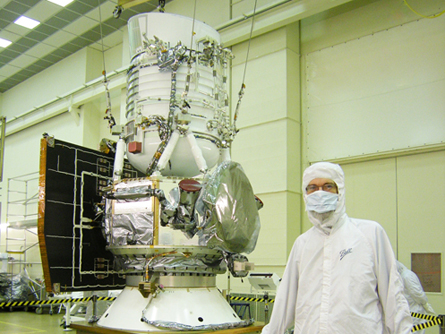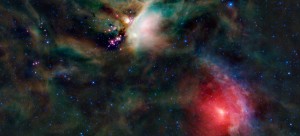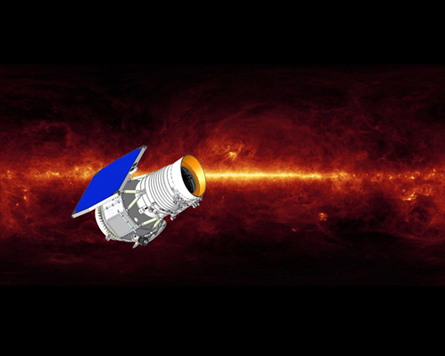Small but WISE
A new telescope will scan the entire sky and see (infra)red
 |
|
Wide-field Infrared Survey Explorer project scientist Peter Eisenhardt stands next to the fully assembled satellite.
|
| NASA’s Jet Propulsion Laboratory, Caltech, Ball |
Anyone on Earth can look up and see the moon or stars, but it takes a telescope to get a glimpse of planets and the other bright and strange things that share our universe. Astronomers are always finding new ways to observe far-off galaxies and study the mysteries of deep space.
That’s why, on December 14, NASA blasted a small but mighty telescope into space. The telescope is called WISE and is about as wide around as a trashcan. Don’t let its small size fool you: WISE has a powerful digital camera, and it will be taking pictures of some the wildest objects in the known universe, including asteroids, faint stars, blazing galaxies and giant clouds of dust where planets and stars are born.
“I’m very excited because we’re going to be seeing parts of the universe that we haven’t seen before,” Ned Wright told Science News. Wright is the scientist who directs the WISE project, which costs about $320 million.

Since arriving in space, the WISE telescope has been circling the Earth, held by gravity in a polar orbit (this means it crosses close to the north and south poles with each lap). Its camera is pointed outward, away from the Earth, and WISE will snap a picture of a different part of the sky every 11 minutes. After six months it will have taken pictures across the entire sky.
The pictures taken by WISE won’t be like everyday digital photographs, however. WISE stands for “Wide-field Infrared Survey Explorer.” As its name suggests, the WISE camera takes pictures of features that that give off infrared radiation.
Radiation is energy that travels as a wave. Visible light, including the familiar spectrum of light that becomes visible in a rainbow, is an example of radiation. When an ordinary digital camera takes a picture of a tree, for example, it receives the waves of visible light that are reflected off the tree. When these waves enter the camera through the lens, they’re processed by the camera, which then puts the image together. Voilà! We see a tree.
Waves of infrared radiation are longer than waves of visible light, so ordinary digital cameras don’t see them, and neither do the eyes of human beings. But we can feel some types of infrared radiation, in the form of heat.
 |
|
An artist illustrated WISE in space, along with a depiction of infrared radiation behind it.
|
| JPL/NASA |
That’s a key idea to why WISE will be able to see things other telescopes can’t. Not everything in the universe shows up in visible light. Asteroids, for example, are giant rocks that float through space — but they absorb most of the light that reaches them. They don’t reflect light, so they’re difficult to see. But they do give off infrared radiation, so an infrared telescope like WISE will be able to produce images of them. During its mission WISE will take pictures of hundreds of thousands of asteroids.
Brown dwarfs are another kind of deep-space object that will show up in WISE’s pictures. These objects are “failed” stars — which means they are not massive enough to jump start the same kind of reactions that power stars such as the sun. Instead, brown dwarfs simply shrink and cool down. They’re so dim that they’re almost impossible to see with visible light, but in the infrared spectrum they glow.
These are just a few of the wonders that will show up in a gallery of WISE’s greatest photos. During its mission, WISE will take pictures of hundreds of millions of stars, asteroids, galaxies and brown dwarfs. Not bad for a flying trashcan!
POWER WORDS (adapted from the Yahoo! Kids Dictionary)
infrared The range of invisible radiation that extends from the long wavelength, or red, end of the visible-light range to the microwave range. Invisible to the eye, it can be detected as a sensation of warmth on the skin.
radiation Emission and propagation of energy in the form of rays or waves.
asteroids Small celestial bodies that revolve around the sun, usually with orbits lying between Mars and Jupiter. They’re usually between a few and several hundred miles in diameter.
galaxy Any of numerous large-scale aggregates of stars, gas and dust that constitute the universe, containing an average of 100 billion (1011) solar masses and ranging in diameter from 1,500 to 300,000 light-years.
telescope An arrangement of lenses or mirrors or both that gathers visible light, permitting direct observation or photographic recording of distant objects.







